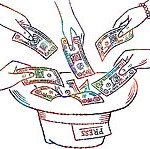Magazines are broke, and so am I.
That’s not completely true. I’ve got a few dollars in the bank, but it appears most magazines do not.
Since the beginning of the year, I’ve been trying to sell a story that is very important to me about the GutterPunks in New Orleans, and a tragic fire that killed eight of them in a squat at the end of last year. The story is much bigger than that, as you will see if you read my previous post: Why Can’t I Sell This Story? These days anyone who is a magazine journalist finds it harder and harder to sell stories, and gets extremely low fees for the work. As a result, fewer good narrative pieces are being published, and many fear this form will die off.
I’m trying something new as of today, a new way of paying journalists to do their jobs, that might help ensure long form, investigative journalism survives. I am trying to fund my story through SpotUs, and I’d like you to make a tax deductible donation to this effort.
What if people financially supported the stories they wanted to read in advance, rather than waiting to see if the editors caught on to subjects that matter to them? That’s the idea behind the website Spot.Us, a venture funded by the John S. and James L. Knight Foundation, a foundation dedicated to advancing journalism in the digital age. Spot.Us is a space where journalists describe the story they are working on and ask the community to help them fund it.
If you go to the Spot.Us website, you’ll see a collection of different kinds of stories: the homeless, nuclear power, school safety, wine making, the labor protests in Wisconsin and my GutterPunks story in the center of the front page. People who want to fund a story click on the description of it to register and pledge their contributions, which are tax deductible. When the project is fully funded, the supporters’ credit or debit cards are charged and the journalist gets the money.
It’s a way of doing journalism that turns the old model of reporting up-side-down. As I raise money for the GutterPunks story, I’m also experimenting with something I call reporting in public.
In the pellet-dropping publishing paradigm, the reporter gets the assignment and works busily behind the curtain under direction of the editors, who get the privilege of unveiling the completed product for the profit of the magazine and its greater glory. In reporting in public, the audience of supporters I develop through Spot.Us and the people who follow my website will be witnesses to the whole process and help shape the story.

Instead of hiding behind the veil, I will post little pieces on my website as I work. The idea is to pay back my investors by giving them inside information on what I am uncovering along the way. If I meet someone interesting, I might post a small profile. When I go to New Orleans to investigate the fire, I expect I’ll post something about my talk with the cops and the coroner. I did a little bit of this last week when I posted a comparison between economic conditions that caused kids to hop trains in the Depression and the ones who hop trains now (very similar). At the end of my reporting, my piece will by published by Boston Review, which has contributed the first $500 to my campaign.
This is an experiment in the kinds of connections and community that is possible on the web, the kind of association that ties us together in a spirit of curiosity, inquiry and innovation.I’m making a plea to you to support my story and this innovative way of doing journalism. My goal is to raise $7000 to cover my travel and time, which the founder and director of the site David Cohn says is difficult to do. Any amount of support is greatly appreciated, from pocket change to the big bucks. Please go to Spot.Us right now and toss in a some wholly tax deductible cash that will make you part of the community that pioneers a new kind of journalism in the digital age.